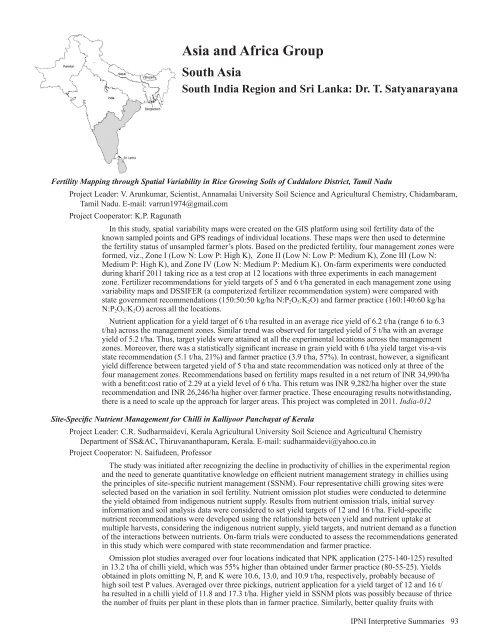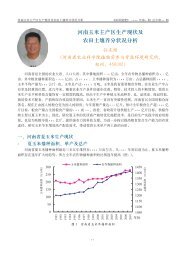Americas and Oceania Group - International Plant Nutrition Institute
Americas and Oceania Group - International Plant Nutrition Institute
Americas and Oceania Group - International Plant Nutrition Institute
Create successful ePaper yourself
Turn your PDF publications into a flip-book with our unique Google optimized e-Paper software.
Asia <strong>and</strong> Africa <strong>Group</strong><br />
South Asia<br />
South India Region <strong>and</strong> Sri Lanka: Dr. T. Satyanarayana<br />
Fertility Mapping through Spatial Variability in Rice Growing Soils of Cuddalore District, Tamil Nadu<br />
Project Leader: V. Arunkumar, Scientist, Annamalai University Soil Science <strong>and</strong> Agricultural Chemistry, Chidambaram,<br />
Tamil Nadu. E-mail: varrun1974@gmail.com<br />
Project Cooperator: K.P. Ragunath<br />
In this study, spatial variability maps were created on the GIS platform using soil fertility data of the<br />
known sampled points <strong>and</strong> GPS readings of individual locations. These maps were then used to determine<br />
the fertility status of unsampled farmer’s plots. Based on the predicted fertility, four management zones were<br />
formed, viz., Zone I (Low N: Low P: High K), Zone II (Low N: Low P: Medium K), Zone III (Low N:<br />
Medium P: High K), <strong>and</strong> Zone IV (Low N: Medium P: Medium K). On-farm experiments were conducted<br />
during kharif 2011 taking rice as a test crop at 12 locations with three experiments in each management<br />
zone. Fertilizer recommendations for yield targets of 5 <strong>and</strong> 6 t/ha generated in each management zone using<br />
variability maps <strong>and</strong> DSSIFER (a computerized fertilizer recommendation system) were compared with<br />
state government recommendations (150:50:50 kg/ha N:P 2 O 5 :K 2 O) <strong>and</strong> farmer practice (160:140:60 kg/ha<br />
N:P 2 O 5 :K 2 O) across all the locations.<br />
Nutrient application for a yield target of 6 t/ha resulted in an average rice yield of 6.2 t/ha (range 6 to 6.3<br />
t/ha) across the management zones. Similar trend was observed for targeted yield of 5 t/ha with an average<br />
yield of 5.2 t/ha. Thus, target yields were attained at all the experimental locations across the management<br />
zones. Moreover, there was a statistically significant increase in grain yield with 6 t/ha yield target vis-a-vis<br />
state recommendation (5.1 t/ha, 21%) <strong>and</strong> farmer practice (3.9 t/ha, 57%). In contrast, however, a significant<br />
yield difference between targeted yield of 5 t/ha <strong>and</strong> state recommendation was noticed only at three of the<br />
four management zones. Recommendations based on fertility maps resulted in a net return of INR 34,990/ha<br />
with a benefit:cost ratio of 2.29 at a yield level of 6 t/ha. This return was INR 9,282/ha higher over the state<br />
recommendation <strong>and</strong> INR 26,246/ha higher over farmer practice. These encouraging results notwithst<strong>and</strong>ing,<br />
there is a need to scale up the approach for larger areas. This project was completed in 2011. India-012<br />
Site-Specific Nutrient Management for Chilli in Kalliyoor Panchayat of Kerala<br />
Project Leader: C.R. Sudharmaidevi, Kerala Agricultural University Soil Science <strong>and</strong> Agricultural Chemistry<br />
Department of SS&AC, Thiruvananthapuram, Kerala. E-mail: sudharmaidevi@yahoo.co.in<br />
Project Cooperator: N. Saifudeen, Professor<br />
The study was initiated after recognizing the decline in productivity of chillies in the experimental region<br />
<strong>and</strong> the need to generate quantitative knowledge on efficient nutrient management strategy in chillies using<br />
the principles of site-specific nutrient management (SSNM). Four representative chilli growing sites were<br />
selected based on the variation in soil fertility. Nutrient omission plot studies were conducted to determine<br />
the yield obtained from indigenous nutrient supply. Results from nutrient omission trials, initial survey<br />
information <strong>and</strong> soil analysis data were considered to set yield targets of 12 <strong>and</strong> 16 t/ha. Field-specific<br />
nutrient recommendations were developed using the relationship between yield <strong>and</strong> nutrient uptake at<br />
multiple harvests, considering the indigenous nutrient supply, yield targets, <strong>and</strong> nutrient dem<strong>and</strong> as a function<br />
of the interactions between nutrients. On-farm trials were conducted to assess the recommendations generated<br />
in this study which were compared with state recommendation <strong>and</strong> farmer practice.<br />
Omission plot studies averaged over four locations indicated that NPK application (275-140-125) resulted<br />
in 13.2 t/ha of chilli yield, which was 55% higher than obtained under farmer practice (80-55-25). Yields<br />
obtained in plots omitting N, P, <strong>and</strong> K were 10.6, 13.0, <strong>and</strong> 10.9 t/ha, respectively, probably because of<br />
high soil test P values. Averaged over three pickings, nutrient application for a yield target of 12 <strong>and</strong> 16 t/<br />
ha resulted in a chilli yield of 11.8 <strong>and</strong> 17.3 t/ha. Higher yield in SSNM plots was possibly because of thrice<br />
the number of fruits per plant in these plots than in farmer practice. Similarly, better quality fruits with<br />
IPNI Interpretive Summaries 93

















